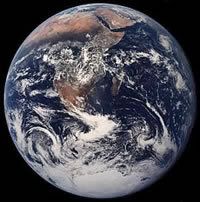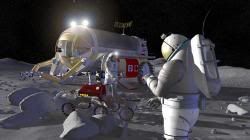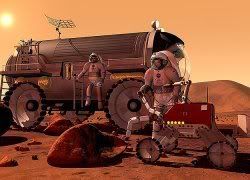Category: Announcements
Carnival Of The Space Geeks (The Lunar Edition)
Whether you are made out of carbon or silicon, I would like to welcome you to the 89th Carnival of Space, hosted by the Moon Society, an organization dedicated to motivating the masses to reclaim our lunar heritage (which was laid down by our forefathers many moons ago--pun intended).
For the multimedia inclined, be sure to check out "a few" of our videos, as well as Lunarpedia (our wiki).
Now without further delay, here is the 89th Carnival of Space! (which will kick off with entries regarding our current terrestrial home, Earth)

From the Homeworld
Wayne Hall of Kentucky Space predicts that by 2020 every company will be asking "What's our space strategy?," while Brian Wang of Next Big Future dreams about Skylon Space Planes (can you say SSTO!).
Meanwhile the mysterious DJ (from Orbital Hub) discusses gravity mapping with NASA's GRACE, while those of you addicted to "all things Twitter" will enjoy an entry by Robert Simpson (from Orbital Frog) regarding celestial (and terrestrial) objects flying over your city.
Ian Musgrave (from Astroblog) enlightens everyone on how to properly convert the "terrestrial masses" via radio interviews while NASA Education introduces a few Do-It-Yourself podcast tools which may aid teachers attempting to create space disciples (hat tip: David Bigwood).

Our Fair Lady Luna
Do you remember everyone's favorite beagle Snoopy? Well, apparently Snoopy and his owner Charlie Brown have some lunar history beyond the cartoon, which CollectSpace highlights.
Speaking of history, Dr. Bruce Cordell from 21st Century Waves discusses whether our landing lunarside was a random fluke or destiny while Mark Whittington wonders why President Obama chose to read The Moon Over Star to 2nd graders, and whether it reveals his vision for NASA.

The Red Planet (and his side kick Pluto?)
Often seen as the red home of humanity, Mars is one planet that seems to excite the masses. Fortunately we have the technology to observe our crimson neighbor up close, as Emily Lakdawalla (of the Planetary Society) publishes a gorgeous image, courtesy of Hubble.
For some though, seeing images is never enough, which is why Ryan Anderson (from Martian Chronicles) is proposing that we voluntarily exile willing subjects to the Martian surface instead.
While Mars does lack beach front property that one would find on Earth, it does however boast some interesting features ranging from depressions (which Phil Plait of Bad Astronomy fame enlightens us about) as well as fresh craters which Stuart Atkinson (of Cumbrian Sky) blogs about.
Although Mars is arguably understood by all to be a planet, Pluto seems to have been left out of this exclusive club, which is why Bruce Irving from Music of the Spheres is calling for Pluto to be recognized as a planet (as dwarf planets are planets too--just smaller).
The Celestial And Extraterrestrial (planetwise that is)
Moving on towards deeper space (and darker objects), Kimberly Arcand (of Chandra Blog) posts a fascinating image of a gluttonous black hole. Speaking of black holes, Carolyn Petersen (from the Space Writer) explains how these monsters are formed (which are often at the center of beautiful galaxies such as these).
If anyone has ever wondered why nebula's are sometimes (unfortunately) called Planetary nebula's, Mike Simonsen from Simostronomy will gladly enlighten you.
Those of you seeking out rocky bodies beyond are star system will be delighted to hear that we have spotted yet another exo-planet which Paul Anderson (from Merid iani Journal) notes is twice the size of Earth!
Unfortunately as Dave Mosher from the Space Disco informs everyone, this planet is probably not habitable as its orbit is just a "little too close" to its parent star.

Questions Without Answers (unless you're an alien)
Does humanity hold a special place in the Universe? That's a question that Ethan Siegel (from Starts With A Bang!) is attempting to answer.
Meanwhile Ian O'Neill of AstoEngine explains why any aliens "next door" may not be able to hear us, while Paul Gilster from Centauri Dreams re-examines the Drake Equation (which could explain why we have not found anybody nearby).
Nicole Gugliucci from One Astronomer's Noise blogs about her adventures at SETI while Timothy Neale of Tomorrow Is Here asks the ultimate cosmic question: what was that noise?
__________________
Thanks for visiting the 89th Carnival of Space, and for those of you seeking to publish your thoughts upon the next round, feel free to visit Universe Today for details on how to enter.
Did Somebody Say Moon Quakes?

First there were earthquakes. Then there were sunquakes. Now it seems as if Earth's little sister may have caught "the shakes" which could threaten future lunar settlements.
(NASA) There are at least four different kinds of moonquakes: (1) deep moonquakes about 700 km below the surface, probably caused by tides; (2) vibrations from the impact of meteorites; (3) thermal quakes caused by the expansion of the frigid crust when first illuminated by the morning sun after two weeks of deep-freeze lunar night; and (4) shallow moonquakes only 20 or 30 kilometers below the surface.
The first three were generally mild and harmless. Shallow moonquakes on the other hand were doozies. Between 1972 and 1977, the Apollo seismic network saw twenty-eight of them; a few "registered up to 5.5 on the Richter scale," says Neal. A magnitude 5 quake on Earth is energetic enough to move heavy furniture and crack plaster.
Furthermore, shallow moonquakes lasted a remarkably long time. Once they got going, all continued more than 10 minutes. "The moon was ringing like a bell," Neal says.
According to NASA, because the Moon (aka Luna) lacks water and an atmosphere to soften the ground below, whenever a lunar quake occurs the whole ground just keeps "vibrating like a tuning fork."
While more data is needed whether to determine how often (and exactly where) do luner quakes occur upon Earth's nearest neighbor, and future settlement established there will probably have to design very flexible outposts (in order to prevent life threatening cracks from appearing in the walls).
Calling alll Bloggers!
Link: http://www.moonsociety.org/volunteer-descriptions.html#bloggers
At the January 21st Management Council meeting, it was decided to do something with our blog. This blog was created to handle daily news from our simulation crew at the Mars Desert Research Station, Feb 26-Mar 11, 2006.
After the simulation was over, I tried to keep it going and for a time I was posting 2-5 times a month. Even that pace is insufficient to keep blog watchers interested.
In between there has, I believe, been one post by Charles Radley and another by James Rogers.
We are now actively looking for more bloggers.
The Planetary Society has an excellent blogger, Emilly Lakdawalla. Not sure if she is a paid volunteer or a staff person, but she keeps it going.
http://planetary.org/blog/
Now NSS has just announced its new blog
http://blog.nss.org
Not sure who is behind that as I just heard about it today in the new NSS Downlink e-letter
Take a look at all the long list of categories listed on the NSS blog page
These suggest a divide and conquer approach. I would be happy to come up with an appropriate list of appropriate categories.
For example, we might get Ken Murphy to post on new books
Someone else on NASA
Someone else on Private Enterprise
You get the idea.
I think this approach has real possibilities.
We could even solicit posts from our chapter leaders, as they will have an "on the ground" approach that may be refreshing.
Our various Project Team leaders (we have ten teams) could post progress updates
I suggest that we work a feed from the NSS blog now that we are mutually affiliated.
Who sees the blog? That was the question to date.
But we are talking about moving the feed for the daily news stories to another page, just keeping the link on the home page, and using that large vacated space for the current blog post.
So how about it?
Email me if you are interested.
kokhmmm at aol.com
Tell me about your blogging experience and about your favorite Moon-related and space-related topics.
Peter Kokh
President, The Moon Society
Moon Society input to the Obama Transition Team on Space
At its January 14th meeting, the Moon Society Management Council, mindful that different members have different ideas about how the nation's space program could be better run and better targeted, has not as yet officially endorsed either of two position papers put together separately by Director of Project Development David A. Dunlop and by Chair of the Publicity and Outreach Committee, James A. Rogers.
Dunlop's paper is extremely comprehensive and commands enormous respect. We urge our members to look at Dave's idea of how US Space programs and initiatives could be reorganized to better lead to the open civilian frontier and Earth-Moon Economy to which the Society pledges its efforts. Dave's recommendations are nothing short of revolutionary, no quarter yielded to those who would just tweak the current program.
http://www.moonsociety.org/whitepapers/3rd-generation-space.html
As of this post, we have only seen the first draft of James Rogers’ paper so we cannot comment on it as yet. Much shorter, it may serve as the Guest Editorial in MMM #222, the February issue of Moon Miners’ Manifesto, next in queue.
Moon Society and Moon Miners' Manifesto introduce new publication for Readers in India: MMM-India Quarerly
Link: http://www.moonsociety.org/india/mmm-india/index.html
November 18, 2008 - With the successful launch and arrival in lunar orbit of Chandrayaan-1, India has become the latest member of the "Lunar Club."
For the Moon Society, India is a most fertile ground in which to spread the Society's international presence. India has the largest English-speaking population of any country in the world. This is a legacy of the long British Raj (rule) prior to India's independence in I947. While Hindi is the official language, it is in fact a regional language in the north, and speakers of other major languages in India prefer to use English, which is everywhere the language of all higher education in India. India publishes more books in English than any other country.
We have already made some contacts in India, notably with the Planetary Society of Youth. We have been busy establishing personal contacts all over India.
Last month, the Society decided to publish a special edition of Moon Miners' Manifesto, MMM-India Quarterly.
http://www.moonsociety.org/india/mmm-india/index.html
The first issue published today includes some key reprints from past issues of Moon Miners' Manifesto that are relevant to India's space ambitions, as well as new matter.
Strategic goals are to grow the emerging space advocacy movement in India, to strengthen existing organizations involved in space outreach, and to develop a cluster of Moon Society chapters in India. There are currently five SEDS (Students for the Exploration and Development of Space) chapters and one National Space Society chapter in India, as well as two home grown student organizations.
The new quarterly publication is a free access pdf file download. While it is directed at Indian readers, it can be downloaded by anyone, Society member or not, without the use of a Society username and password.
The new publication does advertise the established Moon Miners' Manifesto, and the Moon Society, encouraging membership. At this time, however, we want to spread our influence and readership within India, and we believe a free access publication is the best way to do this.
The initial listed editors are: Peter Kokh (Editor of MMM), Madhu Thangavelu (University of Southern California), and David A. Dunlop (Director of Project Development.) The first issue invites contributions from Indian readers, as well as Indian additions to our editorial team. Madhu Thangavelu, currently aboard, was born and raised in India.
Today, the first issue is available for download.
http://www.moonsociety.org/india/mmm-india/m3india1_fall08.pdf
Enjoy!
Comments and Feedback welcome!
 02/07/09 02:13:19 am,
02/07/09 02:13:19 am, 